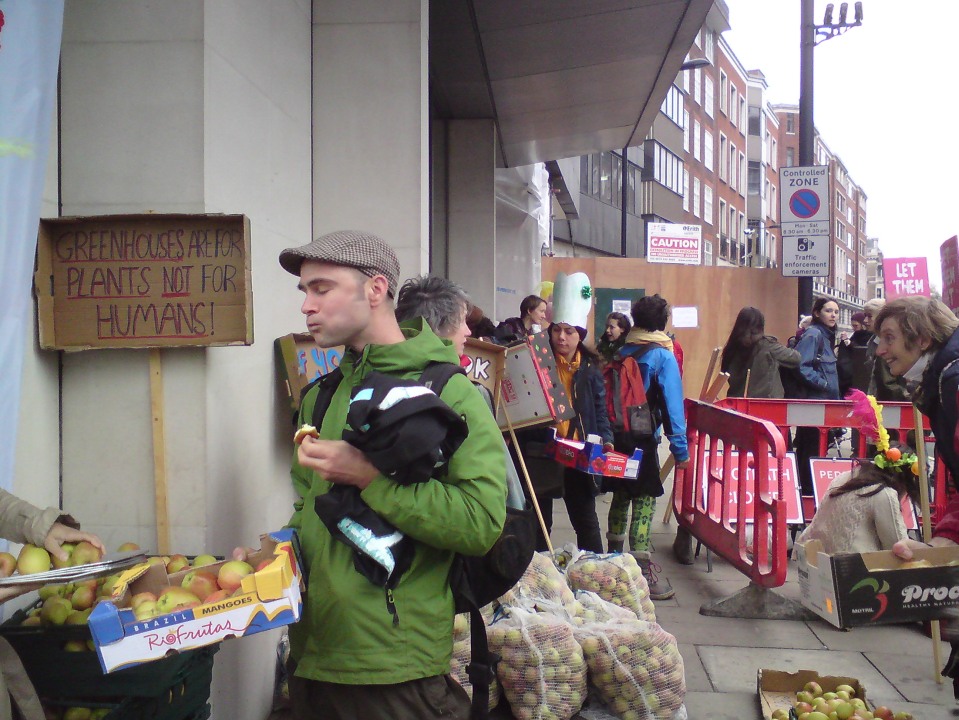On the evening of last week’s Conference of the Parties international climate change conference (COP21) (1), people joined together all over the world to show what we can do and to start doing it…

Gathering of the Food Warriors – A Formidable Scene. The apples shown here are less than half of what was intercepted. Photo by Feedback.
I’m not afraid of anything that’s blocking me/ I’m not afraid of human force”(2)
Even in Paris, where public demonstrations were banned in the days preceding the conference under the ambiguous reason of “security concerns”, more than 10,000 activists managed to make a human chain in a peaceful manifestation (3). However, London’s March was even more demonstrative of our potentiality to create positive change; as we were not demanding anything from anybody, simply showing what we have got.

Many groups were represented at the march, from pandas and clownfish…

To coral reefs…
This was the overwhelming sentiment I got from last month’s People’s March – by the people, for the people. Government “leaders” may have been getting high on the sound of their own voices in Paris, but one thing the March clearly demonstrated was the huge variety of initiatives which are aiding the process of positive societal change, all of which are already functioning in the UK and beyond.

This “hippy” could be recognised by hir placard. Photo by Charlotte Haworth
Free (no price) and Free (liberated)
My role at the March was very particular: as an “exotic waste warrior”, I was showing what I got!
What did I got? Apples! Around 2500 of them, rejected by supermarkets due to “cosmetic standards”, but thanks to the Gleaning Network (4) and This Is Rubbish(5), were intercepted and gifted as sustenance to anyone who came within a hundred feet of us.

Apples for All! Photo by Feedback.
2500 at first seemed quite overwhelming, but in fact they all went amazingly quickly. We began handing out the apples around 11.30am and by the time the March actually began moving around 1.30pm we had only a couple of handfuls left. Such speed of redistribution shows that redirecting abundance can be very simple and easy; especially if we bring the surplus food to a place where there are many hungry people already gathering.
If you eat, you’re in
One key reason to be handing out apples on a march focused on climate change (other than their clear high value in both taste and symbology) is to highlight the impact which food waste has on the environment. Since we currently throw away around 30 – 50% of our food on a global scale even before it gets to a consumer (6), this equates to food waste, if it was a country, being the third largest producer of carbon emissions in the world, after only the USA and China (7).
If you are not a citizen of the USA or China you may think there is not much you can do about the first two, though it may be worthwhile considering where you buy your products from. There is a lot you can directly do about number 3, if you ever indulge in the pastime of eating.
You do? Then read on, as the solutions are delicious!

Enjoying some of the delicious solutions as we handed out the fruit. Photo by Charlotte Haworth
Some tasty ideas
For starters we have harvesting rescuers The Gleaning Network (4) who intercept fruit and vegetables from the fields which would otherwise have gone to waste, and Abundance (8), who map wild fruit trees for DIY harvesting. Then there is national network Fareshare (9) who redistribute supermarket surplus to charities and community groups, and more local versions of this such as Community Food Enterprises (10) in London and the Food Waste Collective (11) in Brighton.
This is Rubbish uses intercepted supermarket fruit and vegetables in tantalising and creative ways to entice and inspire you to do more about saving food.
These groups are doing fantastic work to bring the surplus abundance which already exists to people who are hungry. Yet all are working on the idea that, once the root of the waste is addresd, ideally they would no longer need to exist.
We can all help with this simply by changing our shopping habits. One very easy step is to only buy food produced in your country of residence; as it has had to travel a lot less far and so is less likely to produce carbon emissions or for unnecessary amounts to be thrown away.
Another is to check out This is Rubbish’s new campaign Stop the Rot (12), which is aiming to reduce food waste throughout the UK supply chain.
Enough to whet your appetite? You don’t have to stop here… Food is an issue which affects us all, and eating can always feel good. How do you relate to your food? How can you use this to create a healthier, more energy efficient food system?
The only limit here is your imagination…
References
1. Cop21, 2015. ‘COP21’. http://www.cop21paris.org/
2. Dubioza Kolektiv, 2006. ‘Justce’. Lyrics by Dubioza kolektiv. https://www.gugalyrics.com/lyrics-403779/dubioza-kolektiv-justice.html
3. Ecowatch, 2015. ‘10,000 form human chain in Paris demanding that world leaders keep fossil fuels in the ground’. Ecowatch, 29/11/15. http://ecowatch.com/2015/11/29/human-chain-paris/
4. Feedback Global, 2015. The Gleaning Network’. http://www.thisisrubbish.org.uk/
5. This is Rubbish, 2015. ‘About TiR’. http://www.thisisrubbish.org.uk/
6. Institute of Mechanical Engineers, 2013. ‘Waste Not Want Not’. Imeche: London. Available as a PDF here: http://www.imeche.org/docs/default-source/reports/Global_Food_Report.pdf?sfvrsn=0
7. European Commission JOint Research Centre, 2015. CO2 time series 1990-2013 per capita for world countries. http://edgar.jrc.ec.europa.eu/overview.php?v=CO2ts_pc1990-2013
8. Abundance, 2015. ‘About Us’. http://www.abundancenetwork.org.uk/about-us
9. Fareshare, 2015. ‘About Us’. http://www.fareshare.org.uk/about-us/
10. CFE, 2015. ‘About Us’. http://www.c-f-e.org.uk/About%20CFE.htm
11. HASL, 2015. ‘Food Waste’. http://www.hasl.org.uk/food-waste.html
12. This is Rubbish, 2015. ‘Stop the Rot’. http://www.thisisrubbish.org.uk/project/stoptherot/

Fab! I wonder if such groups are about in the US too..
LikeLike
Excellent that there are so many people joining together to stop the waste. Enjoyed the piece and the photos.
LikeLike